Centauri Dreams
Imagining and Planning Interstellar Exploration
Lupus 3: Into the Dust
An absorption nebula, or ‘dark’ nebula, is a dense cloud of interstellar dust that can block the visible light from objects within or behind it. Today’s image shows a striking cloud in the star-forming region Lupus 3, a dazzling view that simply demanded placement on Centauri Dreams. If you’re looking for an interstellar flight angle, think about the issue of shielding a relativistic starship in regions so dense with gas and dust, zones that can stretch for hundreds of light years. But I need no other angle here — the image is majestic in and of itself.
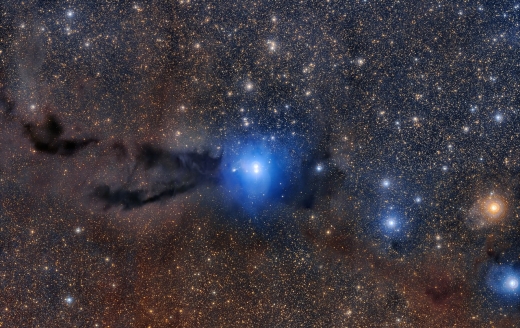
Image: A dark cloud of cosmic dust snakes across this spectacular wide field image, illuminated by the brilliant light of new stars. This dense cloud is a star-forming region called Lupus 3, where dazzlingly hot stars are born from collapsing masses of gas and dust. This image was created from images taken using the VLT Survey Telescope and the MPG/ESO 2.2-metre telescope and is the most detailed image taken so far of this region. Credit: ESO/R. Colombari.
Lupus 3 is found in Scorpius, about 600 light years from Earth, part of the larger complex called the Lupus Clouds. The cold dust absorbs and scatters light as it passes through the cloud, making objects within them viewable only in radio or infrared wavelengths. Frozen carbon monoxide and nitrogen are primary components blocking visible light, but molecular hydrogen, helium and a variety of more transparent ingredients are found within. Some of these absorption nebulae are familiar, great black swathes against background stars, like the Coalsack Nebula.
Lupus 3 is rich in T Tauri stars, variables that are pre-main-sequence stars in the process of contracting. These are young objects that have not yet begun hydrogen fusion at the core but are still powered by gravitational energy as their contraction takes them toward the main sequence. Note the two bright stars in the center of the above image. Growing hotter and brighter, their radiation and stellar winds would have swept out nearby gas and dust, allowing their emergence at visible wavelengths. Our Sun may have formed in a region much like this.
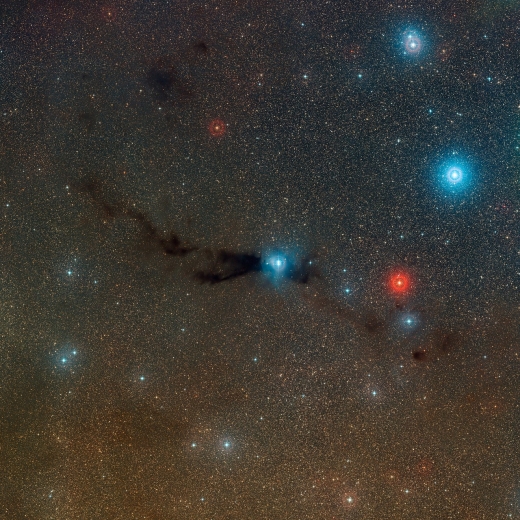
Image: This wide-field view shows Lupus 3, where new stars are forming along with clusters of brilliant stars that have already burst out of their dusty stellar nursery. It is likely that the Sun formed in a similar star formation region more than four billion years ago. This view was created from images forming part of the Digitized Sky Survey 2. Credit: ESO/Digitized Sky Survey 2. Acknowledgement: Davide De Martin.
Shielding a Starship
Let’s get back to interstellar flight issues for a moment. So much depends on where we are traveling when we think about dust mitigation. When the Daedalus designers worked on the first full specifications for a starship back in the 1970s, they included a payload shield some 32-meters in radius. Future starships moving at a high fraction of c would obviously do well to avoid dense nebulae, but we also have to think about shielding fast flyby probes as they enter destination systems, where gas and dust levels can reach dangerous levels.
The Daedalus beryllium shield was one option, and Gregory Matloff has suggested that a forward-firing laser could also be deployed to deflect larger particles along the route. The issue could be significant: Dana Andrews (Andrews Space) has calculated that for a starship moving at 0.3 c, a tenth of a micron grain of typical carbonaceous dust would have a relative kinetic energy of 37,500,000 GeV. We have much to learn about the true size distribution of dust particles in the nearby interstellar medium before embarking on interstellar missions, which is Bruce Draine, author of the definitive Physics of the Interstellar and Intergalactic Medium, is serving as a consultant with the Breakthrough Starshot effort.
For more on star formation in regions like this, see Comerón, “The Lupus Clouds,” in Handbook of Star Forming Regions Vol. II, Astronomical Society of the Pacific (2008), available here in full text. Dana Andrews’ paper is Andrews, “Things to Do While Coasting Through Interstellar Space,” AIAA-2004-3706, 40th AIAA/ASME/SAE/ASEE Joint Propulsion Conference and Exhibit, Fort Lauderdale, Florida, July 11-14, 2004.

Organic Molecules in the Magellanics
If for some reason I had to come up with a different name for Centauri Dreams, I think it might just be Magellanic Dreams. I say this because, like the Alpha Centauri stars themselves, the Magellanics have been something of an obsession since my childhood. Dwarf galaxies orbiting the Milky Way, the Large and Small Magellanic Clouds took my imagination outside our galaxy to a place where it could be viewed in all its splendor (or maybe not: See The Milky Way from Outside for why galaxy viewing can be problematic).
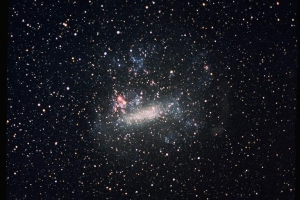
The Large Magellanic Cloud is 160,000 light years away (contrast this with M-31’s 2.5 million light years), while the SMC is about 200,000 light years out. Science fiction brought us Olaf Stapledon’s telepathic aliens living in the LMC — these guys were made to order for the emerging field of Dysonian SETI in that they did engineering on a planetary scale (see Star Maker for more). And remember where the spacecraft in Arthur C. Clarke’s Rendezvous with Rama was heading at the end? It appeared to have used its solar assist to set course for the LMC.
Image: The Large Magellanic Cloud and Supernova 1987A taken by the Kuiper Airborne Observatory (NASA 714) during its New Zealand deployment in 1987. Credit: NASA.
There are too many science fiction references to the Large and Small Magellanics to get into today, from Heinlein’s Have Space Suit Will Travel to Iain Banks’ The Player of Games. I’m now trying to curb my SF enthusiasm (but do read Silverberg’s Collision Course some time to get the backward view of the Milky Way from the LMC). Because what triggered all these thoughts is new work out of the National Radio Astronomy Observatory on the subject of unusual findings in the Large Magellanic Cloud.
Here we’re dealing with data from the Atacama Large Millimeter/submillimeter Array (ALMA). Astronomer Marta Sewi?o (NASA GSFC) and colleagues have found clear evidence of complex organic molecules in the Large Magellanic Cloud, including methanol, dimethyl ether, and methyl formate. The finding raises the eyebrows just a bit because the LMC is nowhere near as rich in heavy elements like carbon, nitrogen and oxygen as our Milky Way — in astronomical terms, these dwarf galaxies exhibit low metallicity. While methanol has been studied in the LMC before, the dimethyl ether and methyl formate are new findings.
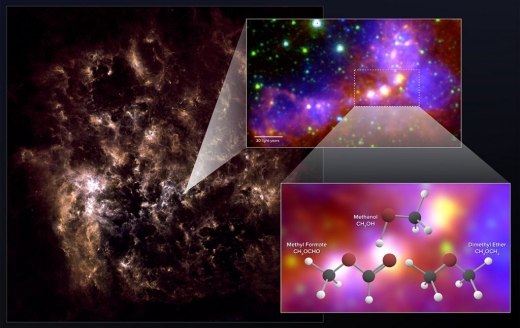
Image: Astronomers using ALMA have uncovered chemical “fingerprints” of methanol, dimethyl ether, and methyl formate in the Large Magellanic Cloud. The latter two molecules are the largest organic molecules ever conclusively detected outside the Milky Way. The far-infrared image on the left shows the full galaxy. The zoom-in image shows the star-forming region observed by ALMA. It is a combination of mid-infrared data from Spitzer and visible (H-alpha) data from the Blanco 4-meter telescope. Credit: NRAO/AUI/NSF; ALMA (ESO/NAOJ/NRAO); Herschel/ESA; NASA/JPL-Caltech; NOAO.
Focusing on two star-forming ‘embryos’ in the LMC (also known as ‘hot cores’), the astronomers think they’re gaining insights into the formation of complex organic molecules in the early universe. That’s because dwarf galaxies with relatively low masses produce a slower rate of star formation, so the LMC may well be chemically similar to distant, younger galaxies. Seeding a galaxy with heavy elements takes generations of star formation and evolution. Says Sewi?o:
“Even though the Large Magellanic Cloud is one of our nearest galactic companions, we expect it should share some uncanny chemical similarity with distant, young galaxies from the early universe… Young, primordial galaxies simply didn’t have enough time to become so chemically enriched. Dwarf galaxies like the LMC probably retained this same youthful makeup because of their relatively low masses, which severely throttles back the pace of star formation.”
The LMC’s N113 Star Formation Region is massive and rich in gas, with a large number of protostars that throw a bright infrared signature. Several of these young stellar objects have produced the spectral evidence for dimethyl ether and methyl formate. The latter two have never been detected at such a distance from Earth, while methanol, a relatively simple compound, is significant because it is essential for the formation of the more complex organic molecules.
Tying these findings to implications for the early universe, the researchers note that the presence of complex organic molecules — molecules containing six or more atoms including carbon — around protostars indicates they would likely be incorporated in emerging protoplanetary disks. Indeed, such molecules may well have been delivered to the young Earth by comets and meteorites. And if chemically primitive regions like the LMC can produce them, then we have the possibility that life could have taken hold early in the history of the cosmos, as these are the building blocks of molecules that are essential to its emergence.
The paper is Sewi?o et al., “The Detection of Hot Cores and Complex Organic Molecules in the Large Magellanic Cloud,” Astrophysical Journal Letters Vol. 853, No. 2 (30 January 2018). Abstract.

Toward Next-Generation Space Telescopes
When you think about what a space telescope goes through to get out of the gravity well and into its planned position, it’s a wonder that instruments this exacting can survive the journey. Launch vibration can reach six times Earth gravity and higher, while temperatures are all over the place as the launch vehicle moves from a temperate climate into the deep chill of space.
Countering all this while ever tightening the parameters of our instruments is a herculean challenge, but there is good news out of Goddard Space Flight Center, where Babak Saif and Lee Feinberg have gone to work on the problem. Working with Perry Greenfield at the Space Telescope Science Institute in Baltimore, the duo have been using an instrument called the High-Speed Interferometer (HSI), developed in Arizona by 4D Technology, to measure the changes that can occur over the surface of a spare 5-foot mirror segment, along with its support hardware, from the James Webb Space Telescope.
The HSI was designed to measure dynamic changes at the nanometer level in JWST optical components, but Saif and Feinberg have been probing even tighter requirements. When we get into the practice of studying exoplanet atmospheres, even atomic-scale distortion can affect a space observatory’s ability to focus and analyze the light of an Earth-class planet, which must be distinguished from the light of its parent star. To achieve this feat, the observatory would have to have optical components that move no more than 12 picometers, which is about one-tenth the size of a hydrogen atom. As demanding as JWST is, this ramps up the challenge.
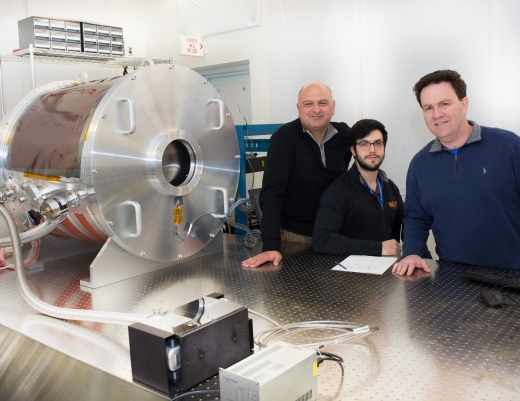
Image: Goddard optics experts Babak Saif (left) and Lee Feinberg (right), with help from engineer Eli Griff-McMahon an employee of Genesis, have created an Ultra-Stable Thermal Vacuum system that they will use to make picometer-level measurements. Credits: NASA/W. Hrybyk.
No observatory yet built, including JWST, has been built that can meet such demanding requirements for stability. But the High-Speed Interferometer has allowed the GSFC scientists to measure dynamic changes across the mirror and structural components. What Feinberg and Saif bring to the table are new algorithms that can take the level of dynamic movement measurement down to 25 picometers, about twice what will eventually be required.
This is measurable progress toward the goal:
“These future missions will require an incredibly stable observatory,” said Azita Valinia, deputy Astrophysics Projects Division program manager. “This is one of the highest technology tall poles that future observatories of this caliber must overcome. The team’s success has shown that we are steadily whittling away at that particular obstacle.”
Working with 4D Technology, GSFC’s team has produced a ‘speckle interferometer’ that allows measurements on both reflective and diffuse surfaces at the picometer-level. The Goddard team is now analyzing its performance in a thermal vacuum test chamber that can control temperatures to the 1 millikelvin level. The plan moving forward is to test items within the chamber to see if the 12-picometer goal is within reach. “We’re getting there,” says Saif.
The key in this testing regime is to test at the same level across the entire structure of the telescope, not just movement between its mirrors. These HSI tests are encouraging, leveraging an instrument developed to work with the Webb telescope’s 18 mirror segments, mounts and supporting structures. Splitting light and recombining it to measure the effects of motion and vibration, the HSI allows the scientists to examine changes across the entire telescope.
The introduction of the speckle interferometer now points to the 12-picometer accuracy our future missions will demand. This is good news all around for atmospheric biosignature analysis.

The Likelihood of Massive Exomoons
Are there large moons — perhaps Earth-sized or even bigger — around gas giant planets in habitable zones somewhere in the Milky Way? It’s a wonderful thought given how it multiplies the opportunities for life to find a foothold even in systems much different from our own. Centauri Dreams regular Andrew Tribick recently passed along a new paper that addresses the question in an interesting way, by modeling moon formation and orbital evolution under widely varying conditions of circumplanetary disk composition and evolution.
We’re entering new terrain from this site’s perspective, because I can’t recall going deeply into circumplanetary disks before, at least not in the exoplanet context. But Marco Cilibrasi (Università di Pisa, Italy) and colleagues take us through the necessary background issues. We have two primary models for giant planet formation inside a protoplanetary disk, one being core accretion, when collision and coagulation occurs among dust particles to build up a planetary embryo. The other is gravitational instability, when a gaseous clump collapses into a planet.
We learn from Cilibrasi et al. that both of these approaches to gas giant formation predict that circumplanetary disks will form around planets in the latter stages of their formation. Here we have to be cautious, because circumplanetary disks do not track precisely with the behavior of their larger cousins around stars. The circumplanetary disk (CPD) receives a constant influx of gas and associated dust from the upper layers of the protoplanetary disk, the result of gas accretion onto the forming gas giant. We can take the moons of Jupiter as our local analog of this process. Indeed, understanding a CPD is crucial to make sense of moon formation.

Image: An artist’s rendition of a sunset view from the perspective of an imagined Earth-like moon orbiting the giant planet, PH2 b (a planet confirmed by the Planet Hunters project). The scene is spectacular, but how likely is it that gas giants would have moons beyond Mars size? The answer to the question awaits further work in exomoon detection, but the Cilibrasi paper sees massive moons as a serious possibility. Credit: H. Giguere, M. Giguere/Yale University.
A few interesting things about the Galilean moons: We know that Io is rocky, while the three outer satellites contain a good deal of water ice. The paper points out that icy satellites can only emerge from a circumplanetary disk with temperatures that have dropped below the water freezing point. But simulations of such CPDs show temperatures as high as several thousand Kelvins. This is an indication that the Galilean moons must have formed very late in the process, when Jupiter had substantially cooled and the circumplanetary disk was beginning to dissipate.
Cilibrasi and colleagues performed hydrodynamic simulations that varied the conditions in the circumstellar as well as circumplanetary disks. 20,000 systems were put into play to study the formation, migration and further accretion of the resulting ‘satellitesimals.’ What happens is striking, for because of the continuous influx of dust from the CPD, high-mass satellites form and migrate into the planet, polluting its atmosphere with metals. From the paper:
Our results show that the moons are forming fast, often within 104 years (20 % of the population), which is mainly due to the short orbital timescales of the circumplanetary disc. Indeed the CPD completes several orders of magnitude more revolutions around the planet than the protoplanetary disc material can do around the star at the location of Jupiter. Due to the short formation time, the satellites can form very late, about 30% after 4 dispersion timescales, i.e. when the disc has ? 2% of the initial mass.
During this period of formation, the circumplanetary disk continues to cool off, finally allowing icy moons to form. In fact, the Cilibrasi simulations show that 85 percent of surviving moons contain water ice. The authors found that the satellites lost to the forming planet account for 0.3 Earth masses on average, up to 10 Earth-masses in some cases, thus contributing to the abundance of heavy metals found at Jupiter. But the high mass of the satellites formed by these simulations is an encouraging result.
Even though surviving satellites form late, when the circumplanetary disk has dwindled to about 2 percent of its initial mass, the moons that form out of this late process can be massive, as the paper notes, a distribution “peaking slightly above Galilean masses, up until a few Earth-masses.” This should put the moons around close-orbiting gas giants within range of projects like the Hunt for Exomoons with Kepler. As for exomoons in a habitable zone and the interesting astrobiological implications they offer, we can hope that future breakthroughs in instrumentation will allow us to test these findings.
The paper is Cilibrasi et al., “Satellites Form Fast & Late: a Population Synthesis for the Galilean Moons,” submitted to Monthly Notices of the Royal Astronomical Society (preprint).

Europa’s Surface: Problems for a Lander?
What do asteroids 44 Nysa, 64 Angelina and the Galilean satellites Io, Europa and Ganymede have in common? They are all Solar System objects without an atmosphere that are highly reflective. They are also the subject of study in a new paper from Robert Nelson (Planetary Science Institute) that investigates a feature common to all: At small phase angles (the angle from the Sun to the target being observed), they show negatively polarized light.
Light reflected from objects in the Solar System is usually polarized, meaning that the electric and magnetic vibrations of the electromagnetic wave occur in a single plane. The amount of polarization depends upon the reflective material, but also on the geometry, as a good astronomy textbook makes clear (I’m checking against Karttunen et al.’s Fundamental Astronomy, 6th ed., 2016).

Image: The phases of Rhea. Emily Lakdawalla used these Cassini images to explain phase angle in a useful 2009 backgrounder. Her caption: The angle from the Sun, to a moon, to the observer is called “phase angle.” This montage shows Saturn’s moon Rhea as seen by Cassini through a clear filter at a variety of phase angles. The images have been resized to a constant pixel scale and rotated so that the terminator is up-and-down; the images sample a variety of latitudes and longitudes. Credit: NASA / JPL / SSI / montage by Emily Lakdawalla.
Polarization at phase angles of greater than about 20° from a body without an atmosphere are positive, while closer to opposition, the polarization is negative. Looking at the polarization behavior of the Jovian moons and asteroids he studies, Nelson and team deduce that their long-observed negative polarization at low phase angles can be explained by extremely fine-grained particles with void space above 95 percent. The surface material, in other words, would feature grain sizes on the order of the wavelength of light of the observations, or a fraction of a micron.
The inference is that these objects are covered with material that is less dense than newly fallen snow. This is a significant result, given that in the long term, we have hopes of placing a lander on Europa that can explore some of the intriguing surface material that may represent upwellings from the ocean below. The question becomes: Would a lander simply sink into the surface before it could do its work?
“Of course, before the landing of the Luna 2 robotic spacecraft in 1959, there was concern that the Moon might be covered in low density dust into which any future astronauts might sink,” Nelson said. “However, we must keep in mind that remote visible-wavelength observations of objects like Europa are only probing the outermost microns of the surface.”
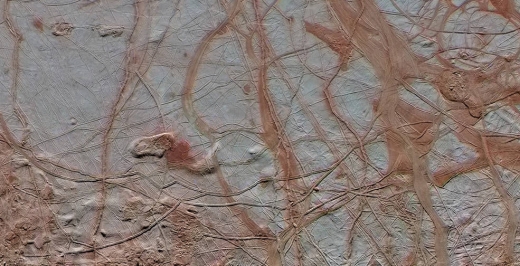
Image: This enhanced-color view from NASA’s Galileo spacecraft shows an intricate pattern of linear fractures on the icy surface of Jupiter’s moon Europa. Credits: NASA/JPL-Caltech/ SETI Institute.
Notice that three Galilean satellites are implicated in this work, meaning that we may have comparable issues at Io and Ganymede. Nelson’s reminder of the Luna 2 landing has in turn reminded me of a 1963 novel by Jeff Sutton called Apollo At Go, an extrapolation based on where the manned space program was at that time of what a lunar landing might involve. Here, too, we had dust as a major feature, this time of a science fiction plot. Indeed, the cover blurb for the book includes this look at a projected first lunar landing:

They were hurtling over it, hurtling and dropping. He fought his harnessing to learn closer to the port… There a small crater, here a hill, a crevice, a milky rectangle that looked absolutely smooth and rock hard — this was an inferno without fire, a hell, the architecture of a maddened nature. The House of Lucifer…
“Zero percent fuel,” Kovac rapped out edgily.
“May says zero on the fuel. Still going down. Trying to hold steady, but can’t. Ash looks deep, deep… Rocks right next to us jagged and — Oh, there she goes… main engines off. Small jets can’t… We’re falling…”
I would think ‘zero percent fuel’ would indeed make Kovacs’ voice a bit edgy.
Sutton, a newspaperman, public relations professional and former Marine, may have been wrong about the dangers posed by the lunar surface, but he was spot on in a different regard. He sets up his Moon landing on July 8, 1969, just twelve days before the actual event. And as to the dust, he was actually writing before we had enough data from the Soviet Luna program and the Surveyor landings to ease scientists’ worries. Let’s hope we’re as well informed about Europa’s surface against the day when our first robotic lander sets down there.
The paper is Nelson et al., “Laboratory simulations of planetary surfaces: Understanding regolith physical properties from remote photopolarimetric observations,” Icarus Vol. 302 (1 March 2018), 483-488 (abstract).

On Ursula Le Guin (1929-2018)
Thinking about Ursula Le Guin takes me to a single place. It is a snow-driven landscape, a glaciated world of constant winter called Gethen, whose name means ‘winter’ in the language of its people. I was reading The Left Hand of Darkness while snow pelted down outside one afternoon in upstate New York, waiting for my wife to get back from her teaching job, nursing a cup of tea and finding my mental location fusing with Le Guin’s fascinating world.

For The Left Hand of Darkness was a spectacular introduction to Le Guin. I had seen her name and even had, somewhere in the stacks, a copy of her first novel, Rocannon’s World (1966), part of an Ace Double that I never got around to reading. The Left Hand of Darkness came out in 1969 but it was in the late 70’s that I read it. I had been through “The Word for World is Forest” when reading Again, Dangerous Visions (1972), one of Harlan Ellison’s anthologies, and although it won a Hugo Award in 1973, I hadn’t found it as much compelling as didactic and all too linked to its era.
I just wasn’t, in other words, prepared for The Left Hand of Darkness, which explores a world in which the inhabitants have no fixed sex. I had read Samuel Delany’s Triton (1976), which deals in some of the same themes, without enthusiasm — I would learn later that Delany saw connections between the novel and Le Guin’s later novel The Dispossessed (1974) — although positing a world where people can change appearance and gender at will provided Delany with vast terrain for exploration.
Image: Front cover of the first edition, with art by the Dillons. Cover depicts two faces against an abstract background. Credit: Wikimedia Commons.
What made The Left Hand of Darkness stand out for me was simply the quality of its prose. Le Guin wrote the novel without sacrificing narrative flow, mining her subject with the gaze of a person who had been raised by two anthropologists (her mother’s book Ishi in Two Worlds (1960) had been widely acclaimed for its look at Californian Indian culture), but she was much more than a chronicler of scientific detail. A dispassionate eye couples in the novel with an explorer’s growing wonderment at place, at people. And the language…
Even as I think this the world’s sun dims between clouds ragathering, and soon a flaw of rain runs sparse and hard upriver, spattering the crowds on the Embankment, darkening the sky. As the king comes down the gangplank the light breaks through a last time, and his white figure and the great arch stand out a moment vivid and splendid against the storm-darkened south. The clouds close. A cold wind comes tearing up Port-and-Palace Street, the river goes gray, the trees on the Embankment shudder. The parade is over. Half an hour later it is snowing.
I can’t speak about The Dispossessed (1974) because I’ve never read it. In fact, there is a great deal of Le Guin I haven’t read. But when the writer died on Monday, I was reminded of my frequent intention of getting into her essays. A new volume called No Time to Spare: Thinking About What Matters had gone on my Amazon wishlist as soon as I saw it in 2017, but I also wanted to cycle back around to her Earthsea series.
As for The Left Hand of Darkness, though, what sticks with me as well as the evocation of place and the vivid sense of snow is the idea behind its civilization. The Hainish universe, beginning with Rocannon’s World, assumes that humans evolved not on Earth but on a planet some 140 light years away called Hain. Because its inhabitants colonized many stellar systems, the possibility was strong that any exploratory vessels from Earth would encounter populations that had been seeded as we had on their worlds. The effort becomes one of re-creating a lost interstellar civilization, using starships traveling close to the speed of light.
I’m told that the ansible was introduced in Rocannon’s World as a way of communicating instantaneously, so a civilization otherwise bound by lightspeed could manage its affairs. Many authors have used an ansible in their work since (and I also think of Dave Langford’s science fiction news and tip-zine of the same name). Le Guin’s galactic civilization becomes known as the Ekumen by the time of The Left Hand of Darkness, comprising fully 83 worlds.

Image credit: Dana Gluckstein
I like the fact that Le Guin contrasted science fiction, which she insisted could be serious literature, with some of the creative-writing-workshop fiction that is all too easily churned out today:
“The thing to remember, however exotic or futuristic or alien the mirror seems, is that you are in fact looking at your world and yourself. Serious science fiction is just as much about the real world and human beings as realistic novels are. (Sometimes more so, I think when faced with yet another dreary story about a dysfunctional upper middle class East Coast urban family.) After all, the imagination can only take apart reality and recombine it. We aren’t God, our word isn’t the world. But our minds can learn a lot about the world by playing with it, and the imagination finds an infinite playing field in fiction.” Interview, Electric Lit, August 7, 2014
The Left Hand of Darkness took both Hugo and Nebula awards and became a fixture wherever science fiction was taught in the academy, surely the first SF novel to do so. No less a figure than Harold Bloom described the book in his monumental The Western Canon. I may not be the only writer who sees Le Guin invariably through its lens.
The New York Times has a fine obituary for Le Guin, as does the Washington Post, but if you want to get to know her views up close, read John Wray’s interview in the Paris Review. What a fine, spirited person! Here Wray, who is no slouch at working science fictional elements into his own novels, asks her about the genre:
I don’t think science fiction is a very good name for it, but it’s the name that we’ve got. It is different from other kinds of writing, I suppose, so it deserves a name of its own. But where I can get prickly and combative is if I’m just called a sci-fi writer. I’m not. I’m a novelist and poet. Don’t shove me into your damn pigeonhole, where I don’t fit, because I’m all over. My tentacles are coming out of the pigeonhole in all directions.


